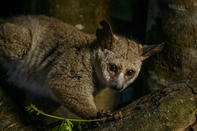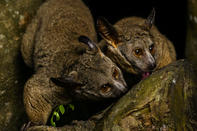Box for Territory
Bushbabies mark their territories and their dominance in a process known as ‘urine-washing’. By urinating into a cupped hand and then rubbing this on the feet, bushbabies spread their scent wherever they move.

This may also be rubbed onto the chest of the male as a sign of dominance or onto a female in courtship. Bushbabies also have chest glands which are utilized in mating and dominance rituals.
Bushbabies will fight to ward off intruders sitting up on the hind legs and holding the fists up ready to ‘box’. Fights can be vicious and involve wrestling and biting so intense it sometimes proves fatal. Young bushbabies start practising their wrestling skills from just 6 days old. Older youngsters will comically hang upside down by their feet while they cuff and wrestle.
The bushbabies brilliant leaping ability is effected by enlarged powerful hind legs and the long tail is used for power and balance. Primate-like hands and feet with nailed fingers and dexterous thumbs and toes assist with grip. The ends of the digits are padded with soft friction pads as well as the palm of the hands and the soles of the feet.
These also help with grip and with capturing prey. They are able to land and grip with just their feet to keep their hands free for grasping prey. Bushbabies can leap horizontally up to 4 m and vertically almost 2 m. They cover many metres in just a few seconds and more than a kilometre in a night with these impressive leaps and bounds. On the ground, bushbabies hop like miniature kangaroos.
Prolific Groomers

Bushbabies hide by day inside tree cavities, dense vegetation or self-built nests. They sleep together in small family groups, except for the males who sleep apart. At night they split up and forage alone provided the weather isn’t foul.
Before leaving to forage, bushbabies, like other primates, take some time to wake up, stretching and grooming. A specially curved grooming claw is present on the second digit of the hind foot. This is also known as the ‘toilet claw’ and is used particularly to groom the head, shoulders and ears.
The tooth comb, also used for scraping gum, is used to groom their fur. A sharp fleshy comb under the tongue is then used to clean debris out of the tooth comb.
Parking
Young bushbabies leave the nest for the first time at just ten days old. They are carried around by the mother so that they are not vulnerable to predation while she is away. The female carries the young by the scruff of the neck just like a carnivore and does not have them cling to her like monkeys.
She moves them between nest sites regularly so that parasites do not build up. When she forages she leaves them clinging to a branch nearby, which is known as ‘parking’.
By four weeks old, the young resist going back to the nest and the female then rolls them around until she can get a grip on the nerves under the skin on the scruff of the neck, which relaxes (paralyses) them into submission.
By Megan Emmett